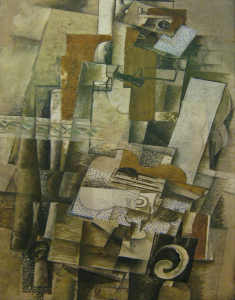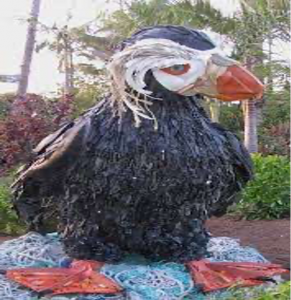Jenna Dempsey
Jenna Dempsey

“Man With a Guitar” by Georges Braque licensed under CC BY-NC 2.0
“Georges Braque, Man with a guitar” by f_snarfel is licensed under CC BY-NC 2.0

“Trash People” by Ha Schult licensed under CC BY 2.0
“‘Trash People’ by HA Schult” by dbking is licensed under

“Washed Ashore: Art to Save the Sea” by the Smithsonian’s National Zoo licensed under CC BY-NC-ND 2.0
“Smithsonian’s National Zoo presents “Washed Ashore: Art to Save the Sea”” by Smithsonian’s National Zoo is licensed under CC BY-NC-ND 2.0
Preface: My name is Jenna Dempsey and I researched garbage art/recycled art. The title of my work is “Recycled/Garbage Art’s Impact and Hidden Meaning.” I chose the license CC BY-SA
Introduction: I focused on garbage art or recycled art as a whole. I began by researching how garbage art began; it all started with collages. Two big college artists are Pablo Picasso and Georges Barques. Garbage art started to grow in popularity over time as pollution increased and more artists incorporated other materials in their work (hence collages). Three pieces of work I feel really capture the meaning and history of garbage art are, “Man with a Guitar”, “Trash people”, and “Washed Ashore: Art to Save the Sea.” The meaning and background of most of these art pieces have similar backgrounds and have similar end goals. Garbage art has a great impact on our work today; possibly greater than any other artist expression. This artistic expression really puts meaning to the saying “ones mans trash is another mans treasure.” Today, there are many well known trash art artists; some examples are, Khalil Chishtee, Ptolemy Erlington, Ha Schult, and many more!
Themes: Recycled art can have many meanings or themes behind it. Two I feel really speak to me are, new life and human flaws. New life erupts with the creation of a new piece of work. Digging a little deeper, there is a greater meaning of new life. Garbage art utilizes trash from other people usually found somewhere within the environment. Every time someone picks up trash off the ground (even just one piece), this helps save the world. That one piece of plastic could’ve made it into the ocean killing a turtle, a fish, a bird, etc. With these artists eliminating trash they are allowing animals, fish, plants, etc. to live a longer and healthier life. This will also allow more offspring to be created ultimately leading to the creation of new life. Picking up just one piece of trash can save so many species and help the world in ways people may not recognize.
How can garbage art really point out human flaw? Well, all the trash these artists are using come from people. The Smithsonian’s “Washed Ashore: Art to Save the Sea” only utilizes trash from the ocean. Without human flaws, we wouldn’t have this much trash readily available. “Trash People” by Ha Schult only uses trash picked up along streets and towns. These artists aren’t using their own trash or recycled garbage. They are going around picking garbage up that was placed/thrown wherever humans please. A big flaw of humans is lack of consideration for the environment. One of those careless acts is littering. These pieces show how much garbage there really is. If is wasn’t a big issue, artists wouldn’t emphasize it in their work. Additionally, there wouldn’t be so much trash readily available to make an abundance of these pieces! These pieces may be beautiful but, the world would be much better place without all this trash in it.
Analysis: Each of these three pieces come from different times and artists but have similar background information. “Man With a Guitar” by Georges Braque was created in 1912. It is currently on display at the MOMA in New York City. Braque collaborated with Picasso on this piece; they wanted to challenge the use of space but also incorporate the intensity of their time. This is a little different than the other two pieces because, during the 1912’s compared to the world we have today, peoples focuses were different. Back in the 1912’s there was a lot of fighting and war. There wasn’t as much “peace” as we have today. Also, todays people are much more materialistic with their items and don’t connect with the world and their environment as much. This is an important piece because, their work led to todays version of garbage art.
“Trash People” by Ha Schult was created next. It was created in the 1960’s to shed light on, the environmental use of plastics and the waste generated by people. During this time period, some people were still living in towns where garbage might have been thrown out the window with no care for the environment. Others, were able to live in nicer towns where sanitation was a thing. Schult gathered a group of about 30 people to collect trash from around the area they were working. Then, they brought the trash together to build these sculptures to put on display. The trash people were then displayed in areas where many could see so they could recognize what they were doing. He traveled around building these people in different locations to point out that these problems occurred everywhere! Ha Schult was a big advocate on the environment and spoke a lot about needing politicians that would be willing to make a change.
Lastly, the Puffin is part of a project at the Smithsonian National Zoo. On display, are many animals made out of debris and trash washed ashore along the ocean. The artist wanted to point out the dangers of pollution and become an activist for the environment. These creations were made within the past 15-20 years. The ability to create so many large masterpieces shows how pollution and littering is only getting worse over time. All three of these pictures could represent artists trying to reach the younger generations to force change. They could also foreshadow future events of filling the world with more trash instead of cleaning up the environment.
Application: Recycled art was created to shed light on the worlds issues. Each art work I picked is from a different time period but they all depict similar messages and meanings. “Man With a Guitar” has the same depressing feel as the two others because of its lack of color. It lead to the creation of recycled art which is why I chose it; it gives the history of this artistic expression. It portrays a bit of a different meaning but it is still challenging ideas of others. “Trash People” and “Washed Ashore: Art to Save the Sea” both challenge peoples ideas that the world we have made today is okay. In reality, it is not; we are killing our environment out of convenience! These works show how society has evolved from war to a war with littering (human flaw). This artistic movement points out how people have changed their focus from surviving off the environment (ex. hunting and gathering) to thriving in this world without relying heavily on the environment. This in turn, effects the world in many ways and some of the effects can’t be seen with the human eye so, people turn their backs to the issue. Each image depicts the society they were created in, in a different way.

